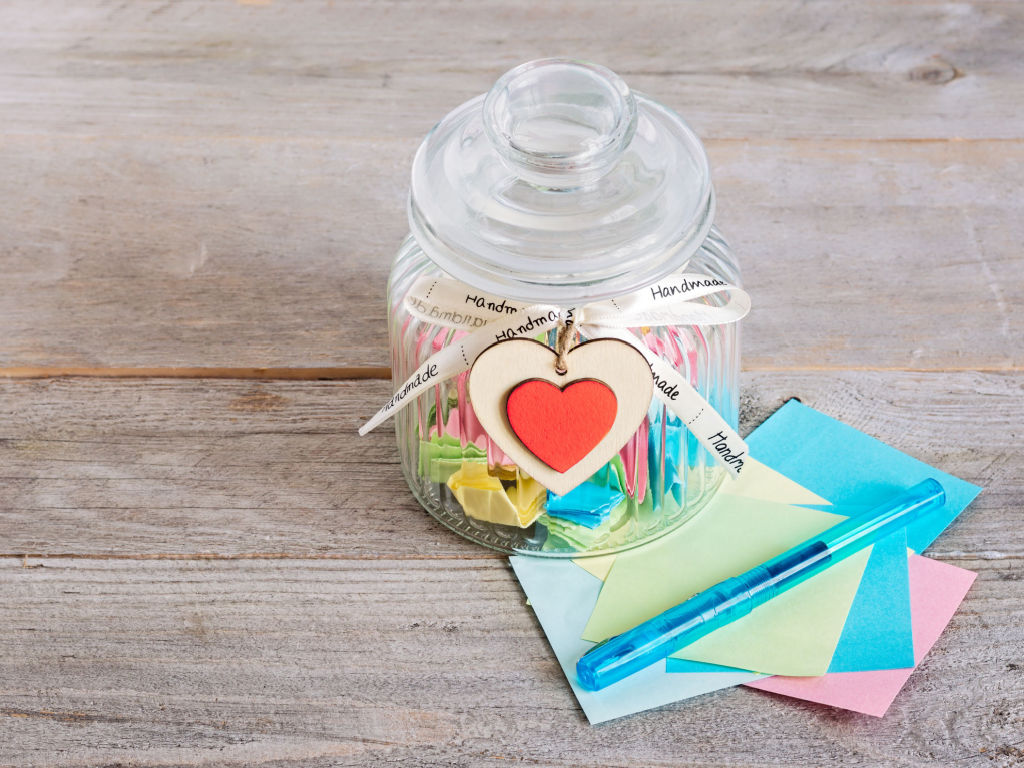
Most people feel grateful when they receive a gift, a job promotion, or a kind gesture or comment from another person. They express gratitude because it’s the right thing to do and makes the other person feel appreciated. But did you know there’s a benefit to you for feeling and saying thank you? This is where gratitude practices come in..
Cultivating a feeling of constant gratitude through the use of consistent gratitude exercises is scientifically proven to improve your mental and physical health.
Gratitude exercises run the gamut of activity, and can be as easy or as involved as you want them to be. These gratitude practices can include:
- Gratitude meditations
- Gratitude journaling
- Gratitude rituals
- Gratitude jars
- Gratitude rocks
- Volunteering
In this article, we’ll explore some simple gratitude activities for adults and children, and learn how you can incorporate these practices into your life to reap the physical and mental benefits of a grateful heart.
Why Gratitude Practice?
According to PositivePsychology.com, a Netherlands-based website dedicated toward teaching psychology practitioners how to employ positive psychology principals, cultivating a grateful mindset has the following physical and mental benefits for most people.
- Better resilience in the face of challenges and the ability to bounce back from stress
- Better self-esteem
- Longer and more quality sleep
- Less aggression and irritability and more understanding
- Better overall wellbeing and less instance of depression
- Fewer overall bodily aches and pains and more physical health
- More friends, because people like being valued and gratitude cultivates authentic relationships
These benefits are all free, because it is completely free to build a gratitude habit. So, how do you make a habit of practicing gratitude? So glad you asked!
Gratitude Practices That Make Great Habits
While some in-depth gratitude exercises exist, the best gratitude activities are the ones that you can easily make into a habit. Gratitude should be practiced often, at least once daily if not more, in order to make it a permanent mindset and reap the benefits mentioned above.
Gratitude Meditations
While meditation on its own is extremely powerful for your psyche, adding a gratitude element can really pack a punch on your overall wellbeing.
Gratitude mediations require little to no practice, whereas regular meditation can be more challenging for beginners because of the requirement of focusing inward for extended periods of time.
For a gratitude meditation, simply sit in a comfortable position and close your eyes. You can do this just about anywhere, as long as you’re in a safe environment.
Focus on and visualize everything you’re thankful for in that moment. Choose one thing at a time, and hone in on how you feel. Savor the moment. Then, move on to the next thing.
You can even make a habit of this exercise with your eyes wide open. As you move through your day, take a moment to appreciate things; perhaps you take an extra minute to feel the steering wheel of the car that you’re grateful is full of fuel, or you literally stop and smell the roses, focusing only on the scent for a full minute.
Soon, your entire day will be filled with things that you’re grateful for, and your mood will be lifted.

Gratitude Journaling
If it’s easier for you to focus on something when you’re writing it down, give gratitude journalizing a try.
You can journal once a day, once a week, or even once a month to signal the end of a month or the start of a new one.
Simply write down a list of what you’re grateful for, and reflect on each item before moving on to the next.
Some people prefer journaling over meditation because it’s less disruptive to their day, has a set time and place, and can be done as a nice way to wrap up or begin the day or week. It makes it easy to form a habit when you wake up next to your journal or put it in a place that you’ll frequently see as a reminder.
Journaling, whether writing about what you’re thankful for or just getting your feelings down on paper, is a healthy practice that can improve your sleep and your mood.
Gratitude Rituals
Creating a ritual surrounding certain gratitude activities is another way to form a habit of being thankful.
For some, this can be as simple as saying “Grace” before dinner, or simply saying aloud that you’re grateful for the food on the table.
You can also make a ritual of asking your spouse what they’re grateful for before you go to bed, then sharing something you’re thankful for in return.
Or, get the kids involved and create a ritual of talking about what you were grateful for that day each night at the dinner table.
Gratitude Activities to Teach Your Kids
Speaking of kids, teaching your children how to be grateful early in life can have significant impacts on their behavior and resilience.
To teach gratitude to your children, try to make the exercises fun, like the examples below. They’ll be more likely to participate consistently in something tactile and visual where they can see and feel the impact of their practice.
Gratitude Jar
Gratitude jars can be fun for the entire family and are easy to put together.
Simply find a jar, basket, or box (though jars are more fun as you can see them fill up over time), and decorate it with the words “Gratitude Jar.”
Nearby, leave strips of paper and colored pens, pencils, or markers.
Encourage your kids to write down what they’re thankful for whenever they’re feeling like they have something to add. Try to avoid forcing a daily ritual, which can make the activity less enjoyable.
Your kids will enjoy watching the jar fill up, and will have fun reading the strips of paper back once the year or month is through.
Put the jar in a space in your home that your kids frequent so they’ll never forget to add a strip of paper every time they feel grateful for something.

Gratitude Rock
Gratitude rocks are a fun craft and gratitude project crossover.
Tell your kids that you’re going rock hunting to find a rock that they want to put on display somewhere in the house. This will be their gratitude rock, and every time they see it, they should be prompted to think of something they’re thankful for and say it aloud or to themselves.
They can decorate the rock as well so it’s something they’re proud to show off.
Volunteering
Volunteering shows your children that it feels good to help other people. It can also show them what they’re privileged to have and make them feel grateful for the wonderful lives they lead.
And volunteering doesn’t have to be formal; kids can volunteer to do their siblings’ chores, clean up their neighbor’s yard, or evens sell lemonade for charity.
Ways to Incorporate Gratitude Into Your Life
Now that you have a list of more formal activities to incorporate gratitude into your life, here’s how to do it on the daily.
Savor Feelings of Gratitude
If feelings of gratitude come up, make sure to take the time to really savor that moment. Rather than just thinking about how grateful you are, really feel it.
Tell Someone You’re Grateful
Sometimes, the most powerful way to feel gratitude is to say that you’re thankful out loud. While it can be uncomfortable if you’re not use to telling people that you’re thankful for them or something they did, it can also be incredibly empowering.
Telling someone you’re grateful helps enhance the feeling of gratitude when you see the reaction from someone else.
Perform Acts of Service
Feeling grateful doesn’t only mean we say that we are. You can show your gratitude, too!
Consider paying it forward if you’re feeling thankful for something, whether that’s paying for a stranger’s coffee or simply holding open a door.
Watch the gratitude multiply!
Final Thoughts on Gratitude Practices
It is easy to incorporate a gratitude practice into your routine and quickly reap the benefits, both for your physical and mental health.
Plus, there are fun ways to make the practice of gratitude something the entire family can get in on!
Try including some of these activities into your own daily life and watch your life improve in ways you never thought possible.